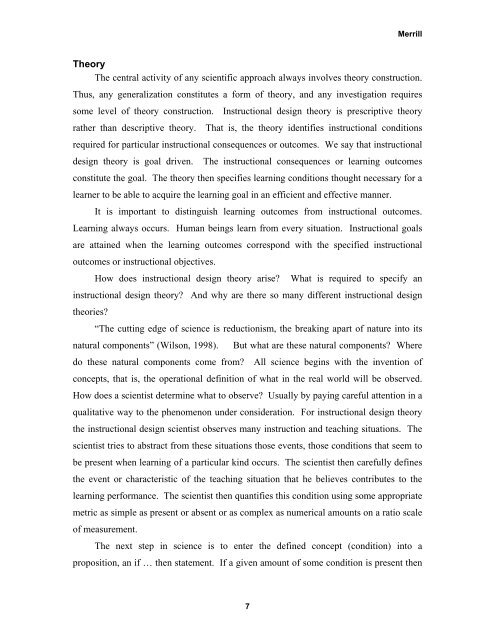The Proper Study of Instructional Design - David Merrill
The Proper Study of Instructional Design - David Merrill
The Proper Study of Instructional Design - David Merrill
Create successful ePaper yourself
Turn your PDF publications into a flip-book with our unique Google optimized e-Paper software.
<strong>Merrill</strong><strong>The</strong>ory<strong>The</strong> central activity <strong>of</strong> any scientific approach always involves theory construction.Thus, any generalization constitutes a form <strong>of</strong> theory, and any investigation requiressome level <strong>of</strong> theory construction. <strong>Instructional</strong> design theory is prescriptive theoryrather than descriptive theory. That is, the theory identifies instructional conditionsrequired for particular instructional consequences or outcomes. We say that instructionaldesign theory is goal driven. <strong>The</strong> instructional consequences or learning outcomesconstitute the goal. <strong>The</strong> theory then specifies learning conditions thought necessary for alearner to be able to acquire the learning goal in an efficient and effective manner.It is important to distinguish learning outcomes from instructional outcomes.Learning always occurs. Human beings learn from every situation. <strong>Instructional</strong> goalsare attained when the learning outcomes correspond with the specified instructionaloutcomes or instructional objectives.How does instructional design theory arise? What is required to specify aninstructional design theory? And why are there so many different instructional designtheories?“<strong>The</strong> cutting edge <strong>of</strong> science is reductionism, the breaking apart <strong>of</strong> nature into itsnatural components” (Wilson, 1998). But what are these natural components? Wheredo these natural components come from? All science begins with the invention <strong>of</strong>concepts, that is, the operational definition <strong>of</strong> what in the real world will be observed.How does a scientist determine what to observe? Usually by paying careful attention in aqualitative way to the phenomenon under consideration. For instructional design theorythe instructional design scientist observes many instruction and teaching situations. <strong>The</strong>scientist tries to abstract from these situations those events, those conditions that seem tobe present when learning <strong>of</strong> a particular kind occurs. <strong>The</strong> scientist then carefully definesthe event or characteristic <strong>of</strong> the teaching situation that he believes contributes to thelearning performance. <strong>The</strong> scientist then quantifies this condition using some appropriatemetric as simple as present or absent or as complex as numerical amounts on a ratio scale<strong>of</strong> measurement.<strong>The</strong> next step in science is to enter the defined concept (condition) into aproposition, an if … then statement. If a given amount <strong>of</strong> some condition is present then7
















